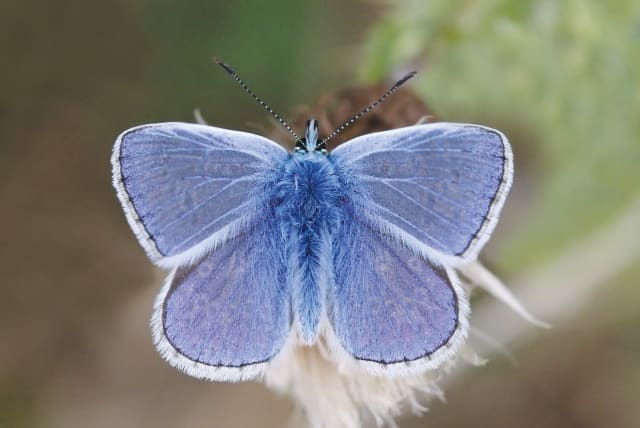My Word: Between butterflies and rockets

Palestinian rockets do not come out of the blue. Unlike Common Blue Butterflies, they should not be treated as one of nature’s wonders but as acts of war.
I was all a-flutter earlier this week with the thought that I could dedicate a column to something beautiful and non-contentious: The announcement that a national butterfly had been chosen in honor of Israel’s 75th anniversary.
I say “non-contentious” although there was a fierce battle among lepidopterists (butterfly enthusiasts, in other words) before the final vote.
And the winner is: the Common Blue Butterfly. True to its name, the butterfly is both common and the males’ wings are a white-rimmed shiny blue on one side and beige with orange and brown spots on the other. A blue-and-white butterfly that can be found throughout most of the country and which can be seen throughout most of the year is a worthy choice.
The contest didn’t bring out the numbers that the protests – for or against – judicial reform have been producing, but nonetheless many felt butterflies in their tummies as the number of contenders was whittled down from some 140 species to 12. The good-natured competition was sponsored by the Israeli Lepidopterists Society (ILS) together with environmental organizations including KKL-JNF, the Society for the Protection of Nature in Israel, the Israel Nature and Parks Authority, and Tel Aviv University’s Steinhardt Museum of Natural History.
The idea was both to find Israel another natural national symbol – alongside the Canaani dog, hoopoe bird, anemone, and the olive tree – and to raise environmental awareness. Butterfly populations everywhere are dwindling due to climate change, construction and urban development which destroy their natural habitats, and the use of pesticides and agricultural practices, among other reasons.
INPA ecologist Dr. Dotan Rotem notes that “the presence of butterflies is evidence of certain environmental conditions – in ecological terms, that sentence can be shrunk into the one word: bioindicators.
“Because of their delicate beauty, they are popular among the general public and therefore we can use them to help examine ecological processes and to explain to the public the changes taking place using butterflies as an example.”
Mazi Magnezi, who heads the INPA’s public information department, shares similar sentiments about the wonders and woes of butterflies. While she encourages people to go out hiking and keep their eyes open for butterflies, she warns against getting too close to take pictures and accidentally harming them or their environment.
AS I WAS warming to my theme, my flight of fancy was brutally cut short midweek. I could not ignore something far less pleasant than butterflies passing through Israel’s skies: a massive rocket barrage from the Gaza Strip.
Amid buttery bliss, rockets fly from Gaza into Israel
More than 100 rockets were launched on southern Israel within 24 hours between Tuesday morning and early Wednesday. The main “credit” (they’re proud of it) goes to the Palestinian Islamic Jihad with help from their friends, Hamas – and no doubt support from the ayatollahs in Iran.
The ostensible excuse was the death of hunger-striking PIJ detainee Khader Adnan, 45, who tempted fate by not only refusing to eat for 86 days but also turning down Israeli offers of hospitalization. Not that Islamic Jihad or any of its ugly siblings need a pretext for launching rockets or other terror attacks. Last month, the country came under rocket fire from Gaza, Syria and Lebanon while despicable terror shootings were being carried out.
In short, my inspiration for a column underwent a change more drastic than the metamorphosis of a caterpillar. I was left with something between the Butterfly Effect and the Prisoners’ Dilemma.
Butterfly Effect and Prisoners' Dilemma
The Butterfly Effect is the concept associated with the work of American meteorologist Edward N. Lorenz. It is used to explain how a small incident in one place can set off a chain of events which may have a momentous impact on the other side of the world weeks later. Events in Iran, Russia and Syria are often felt close to Israeli homes – without having gently traveled on butterfly wings.
Some Israeli officials and observers fear that Hamas and Islamic Jihad are exploiting what the Palestinians perceive as Israeli weakness due to the turmoil over the judicial reform. This includes the threats by some pilots and others not to serve (although in time of war, it is unlikely that the reservists would fail to report for duty if called), the perceived deterioration of ties with the US and the transfer of US military materiel from Israeli stores to besieged Ukraine. And last month’s rockets on three fronts has the imprint of Tehran’s terror tentacles all over them. It’s worth noting that Iranian President Ebrahim Raisi visited Damascus on Wednesday and last week the Islamic Republic’s foreign minister visited a Lebanese village on the border with Israel.
Although the IDF did respond to the rocket attacks, it was rather halfhearted, reportedly targeting some Hamas military sites, including weapons manufacturing facilities, military posts, and a terror tunnel. It seems that neither Israel nor Hamas want a full-blown war. But sporadic rocket attacks cannot be considered “normal” or acceptable. They are war crimes.
Several people were wounded in Sderot, including a Chinese construction worker who suffered moderate wounds. Had the rocket fire caused fatalities, obviously the Israeli response would have been harsher and the situation could have swiftly escalated to the sort of mini-war like Operation Guardian of the Walls in May 2021.
Islamic Jihad and Hamas take a calculated risk trusting that the Iron Dome will prevent the sort of fatalities or damage that will lead to a major Israeli retaliation. They also trust that a massive Israeli response will be condemned around the world while Palestinians can get away with murder.
Meteorological conditions threaten butterflies and the political climate has an effect on terrorist hostilities – and the response. Thousands of miles and much hypocrisy separate those who call for Israeli restraint while ignoring the fact that security depends on deterrence. But there is undoubtedly a challenging dilemma for Israel – whichever government happens to be in control. While wanting peace and quiet many residents of the South say that they’re willing to suffer another mini-war if it meant Israel restored deterrence. They correctly note that there will be no sustainable calm without a deterrent component.
Even without a major operation, Israel could take certain actions, including the targeted killings of terrorist leaders when possible and reducing the number of permits for daily workers who cross into Israel from Gaza. Indeed, as long as Hamas holds the bodies of Oron Shaul and Hadar Goldin (two Israeli soldiers whom it killed and abducted during Operation Protective Edge in 2014) and continues to keep captive two Israeli citizens, Avera Mengistu and Hisham al-Sayed, the practice of failing to put pressure on the terrorist organization remains questionable.
Hamas should be in no place to challenge Israel over the fate of a hunger-striking detainee. But this brings me to another quandary: the prisoners’ dilemma. The term “hunger striker” has been granted a glamorous status through the posthumous global glory awarded to the IRA’s Bobby Sands, among others. Hence hunger striking has become the bread and butter, as it were, of Palestinian prisoners’ protests – perfect for an age when Palestinian public relations is pitted against Israeli public diplomacy.
Israel faces the choice of letting a hunger striking prisoner die – of his own free will – and facing a backlash; force-feeding a prisoner; or giving in to Palestinian demands. Adnan, incidentally, first gained international sympathy in 2012 for a hunger strike during a previous detention. Prison life is no picnic, prisoners are not cocooned, but it is not the hell the convicted terrorists like to pretend it is. Hamas protested a decision by National Security Minister Itamar Ben-Gvir earlier this year to ban ovens from prison cells where Palestinians were able to prepare their own freshly baked pitot. Every attempt at restricting such perks has been met with Hamas and Islamic Jihad threats to escalate into violence, and ridicule from the Israeli political opposition.
Palestinian rockets do not come out of the blue. Unlike Common Blue Butterflies, they should not be treated as one of nature’s wonders but as acts of war. And terrorists should not be allowed to freely spread their wings.
liat@jpost.com
Jerusalem Post Store
`; document.getElementById("linkPremium").innerHTML = cont; var divWithLink = document.getElementById("premium-link"); if (divWithLink !== null && divWithLink !== 'undefined') { divWithLink.style.border = "solid 1px #cb0f3e"; divWithLink.style.textAlign = "center"; divWithLink.style.marginBottom = "15px"; divWithLink.style.marginTop = "15px"; divWithLink.style.width = "100%"; divWithLink.style.backgroundColor = "#122952"; divWithLink.style.color = "#ffffff"; divWithLink.style.lineHeight = "1.5"; } } (function (v, i) { });

